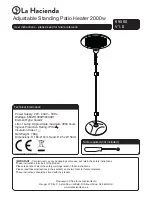
6
110135.01
vetus®
Rigid waste water tanks for grey and for black water
Introduction
These instructions apply to the Vetus rigid plastic waste water
tanks for
grey water
and
black water
.
These tanks are made from low pressure polythene and therefore
have the following properties: they are algae resistant, hardly any
condensation is formed, the material is insulating, the surface is
very smooth, the plastic is indestructible and very environmental-
ly-friendly and there are no electrolysis problems.
Grey water tank
A
grey water tank
should only be used for collecting water from
the sink, shower, wash basin, air conditioning, etc..
The capacity of a waste water tank can never be too large.
Match the capacity to the amount of fresh water available; the
capacity of the water tank(s).
Fit sink, shower, wash basin, etc. with a drain with sieve, so that
coarse waste, such as hair etc., will be less likely to enter the
grey water tank.
Black water tank
A
black water tank
is used only for temporary collecting toilet
waste.
A black water tank should be installed in accordance with
the Recreational Craft Directive (RCD), ISO 8099 Standard.
The capacity of a waste water tank can never be too great. The
capacity should be calculated using the amount of flushing wa-
ter (outside water) used by the toilet. Reckon on 7 to 14 litres
(1.5 to 3 Imp. Gal., 1.9 to 3.8 US Gal.) of black water per person
per day.
Use only water-soluble toilet paper to prevent unnecessary
blockages. N.B: Sanitary towels and tampons in the toilet and
black water tank will certainly cause blockages.
Clearing a blockage is an unpleasant job, make sure you
have a pair of rubber gloves on board.
Smell
Grey water tank
Unpleasant odours will be produced in every grey water tank.
Fit the sink, shower, wash basin, etc., with an S-bend (siphon or
stink trap) and a plug.
Black water tank
Unpleasant smells caused by faeces will be produced in every
blackwater tank. The use of sea water for flushing will increase
the smell. The algae in sea water also produce unpleasant
smells.
It is possible to add special additives to waste water tanks to
reduce the smell, called tank deodorants. A simple way of re-
ducing the smell is by using washing soda, which cleans and
sterilizes.
Leaking hoses, hose fittings, tanks, tank covers, etc., can also
cause a smell nuisance. So carry out a regular check of the
whole system.
For dimensions, see drawing on page 21. Tolerances of +/- 2%
apply to all tank dimensions!
Use
Emptying
Always empty the tank in accordance with environmen-
tal regulations.
There are some regions where direct discharges into
the outside water are forbidden.
The longer waste water remains in the tank, the greater the risk
of smell. SO do not leave a waste water tank full unnecessarily,
but empty the tank on a daily basis, or whenever it is possible.
Emptying the tank:
A ‘pump-out’ system on the jetty is connected to the tank cap.
This will empty the tank out.
When the tank is pumped empty by a high capacity pump, there
is a risk of the tank collapsing due to the under-pressure. This
problem occurs especially with ‘pump-out systems’. In order to
prevent the tank collapsing, one of the following measures can
be taken:
Open the tank inspection cover.
•
Open a valve specially fitted in the tank for this purpose.
•
Install an automatic relief valve.
•
Emptying the tank while sailing:
Open the valve while sailing. Make sure the hull outlet is be-
•
low the waterline (sailing boats when heeling)
Maintain a reasonable speed to prevent odour nuisance.
•
Close the valve after emptying.
•
During your absence
When sinks, wash basins, showers, etc. are not used for a long
time, the water in the S-bends, fitted as a smell trap in the drain
pipes, will evaporate. This will lead to a smell nuisance. So put
plugs in all drains when the ship is not manned for a long time.
Clean and sterilize the tank and pipes at least once a year, pref-
erably at the end of the season.
Cleaning
Grey water tank
Clean the inside of the tank with water and a good degreasing
household cleaner. Use a brush or sponge on a rigid tank. Rinse
the tank with clean tap water.
Black water tank
Clean the inside of the tank with water and a good toilet cleaner,
use household vinegar when there are scale deposits. Use a
brush or sponge on a rigid tank. Rinse the tank with clean tap
water.
Sterilizing
Sterilize the tank by filling with a solution of chlorine bleach
in water (1 : 1000). Allow this solution to circulate through the
waste water system. Remove the solution and rinse tank with
clean tap water.







































